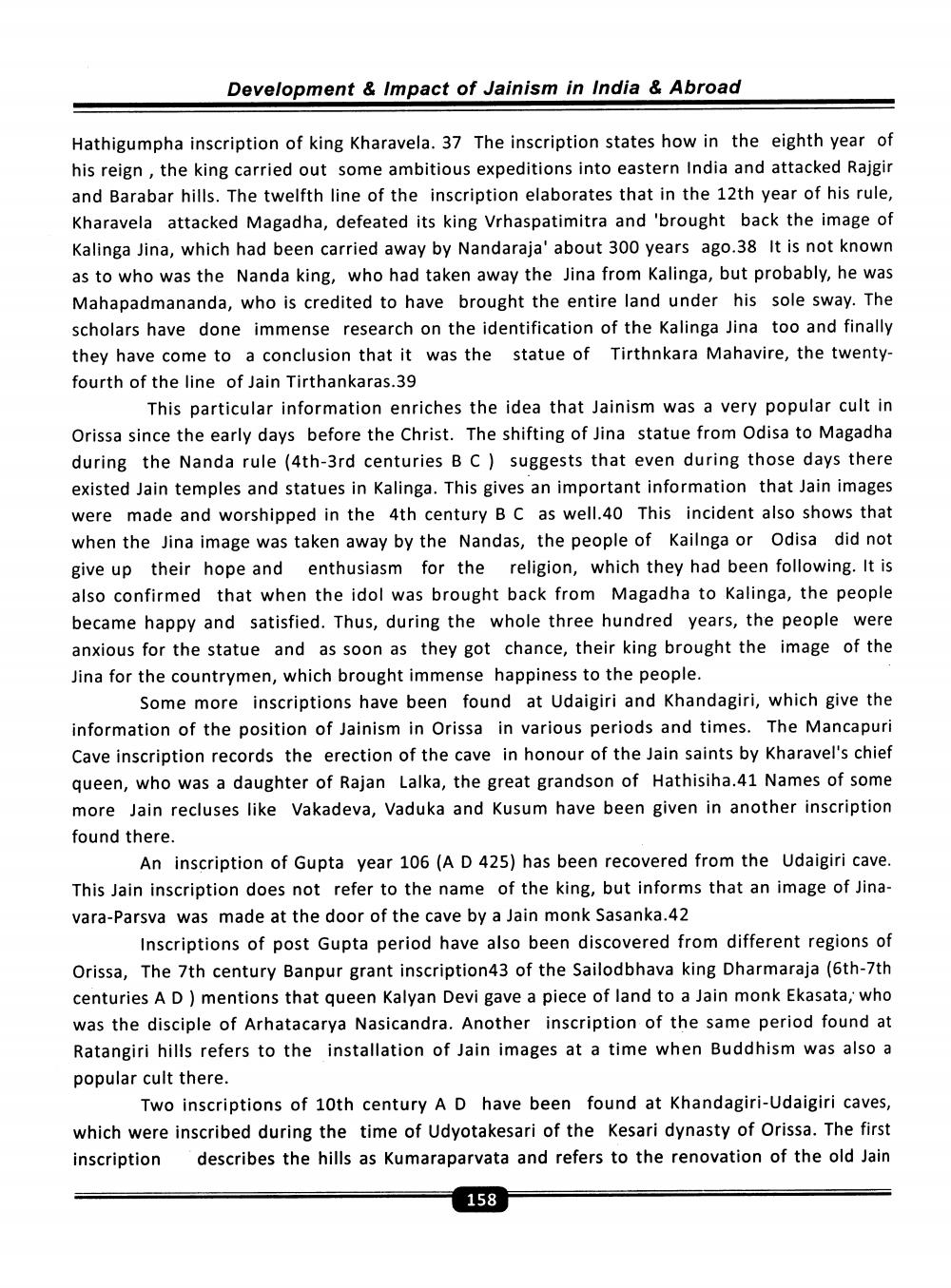________________
Development & Impact of Jainism in India & Abroad
Hathigumpha inscription of king Kharavela. 37 The inscription states how in the eighth year of his reign, the king carried out some ambitious expeditions into eastern India and attacked Rajgir and Barabar hills. The twelfth line of the inscription elaborates that in the 12th year of his rule, Kharavela attacked Magadha, defeated its king Vrhaspatimitra and 'brought back the image of Kalinga Jina, which had been carried away by Nandaraja' about 300 years ago.38 It is not known as to who was the Nanda king, who had taken away the Jina from Kalinga, but probably, he was Mahapadmananda, who is credited to have brought the entire land under his sole sway. The scholars have done immense research on the identification of the Kalinga Jina too and finally they have come to a conclusion that it was the statue of Tirthnkara Mahavire, the twentyfourth of the line of Jain Tirthankaras.39
This particular information enriches the idea that Jainism was a very popular cult in Orissa since the early days before the Christ. The shifting of Jina statue from Odisa to Magadha during the Nanda rule (4th-3rd centuries BC) suggests that even during those days there existed Jain temples and statues in Kalinga. This gives an important information that Jain images were made and worshipped in the 4th century BC as well.40 This incident also shows that when the Jina image was taken away by the Nandas, the people of Kailnga o Odisa did not give up their hope and enthusiasm for the religion, which they had been following. It is also confirmed that when the idol was brought back from Magadha to Kalinga, the people became happy and satisfied. Thus, during the whole three hundred years, the people were anxious for the statue and as soon as they got chance, their king brought the image of the Jina for the countrymen, which brought immense happiness to the people.
Some more inscriptions have been found at Udaigiri and Khandagiri, which give the information of the position of Jainism in Orissa in various periods and times. The Mancapuri Cave inscription records the erection of the cave in honour of the Jain saints by Kharavel's chief queen, who was a daughter of Rajan Lalka, the great grandson of Hathisiha.41 Names of some more Jain recluses like Vakadeva, Vaduka and Kusum have been given in another inscription found there.
An inscription of Gupta year 106 (A D 425) has been recovered from the Udaigiri cave. This Jain inscription does not refer to the name of the king, but informs that an image of Jinavara-Parsva was made at the door of the cave by a Jain monk Sasanka.42
Inscriptions of post Gupta period have also been discovered from different regions of Orissa, The 7th century Banpur grant inscription43 of the Sailodbhava king Dharmaraja (6th-7th centuries A D) mentions that queen Kalyan Devi gave a piece of land to a Jain monk Ekasata, who was the disciple of Arhatacarya Nasicandra. Another inscription of the same period found at Ratangiri hills refers to the installation of Jain images at a time when Buddhism was also a popular cult there.
Two inscriptions of 10th century AD have been found at Khandagiri-Udaigiri caves, which were inscribed during the time of Udyotakesari of the Kesari dynasty of Orissa. The first inscription describes the hills as Kumaraparvata and refers to the renovation of the old Jain
158




